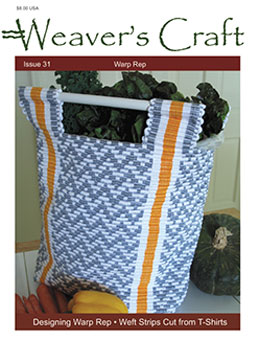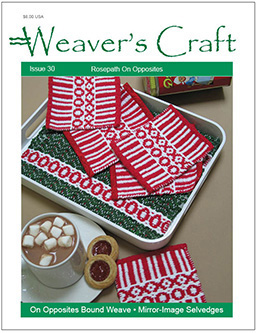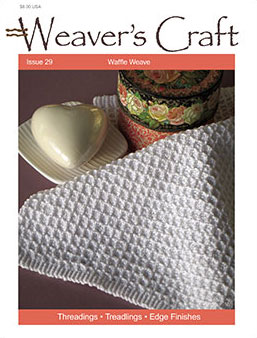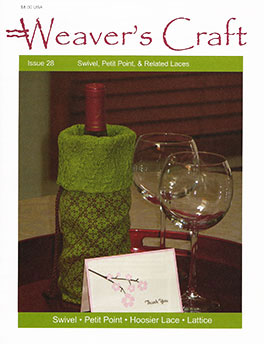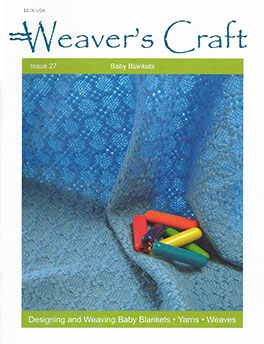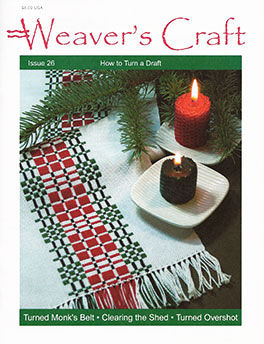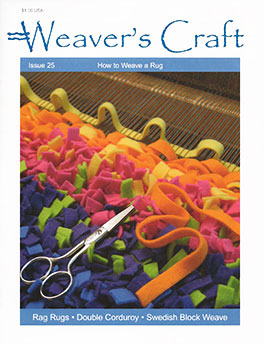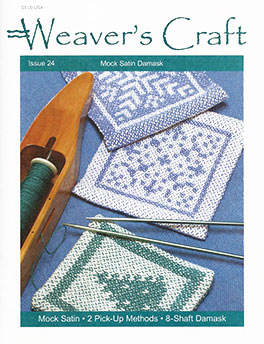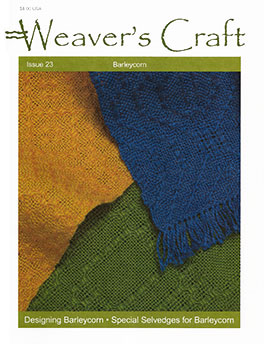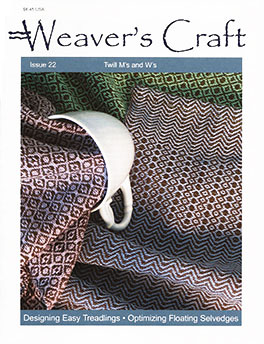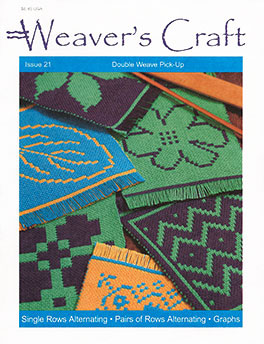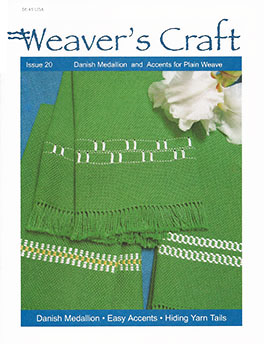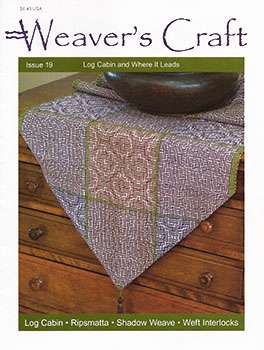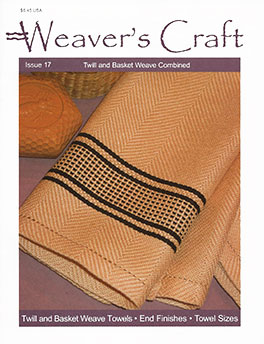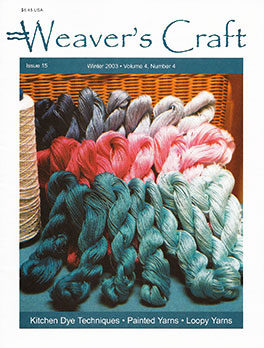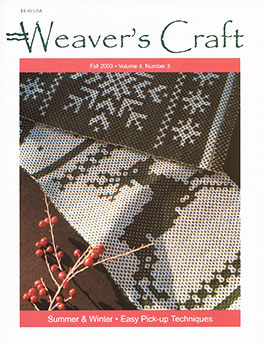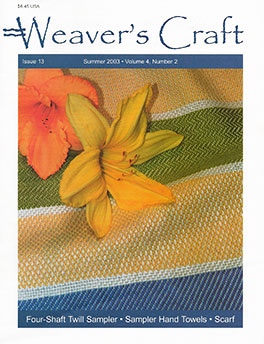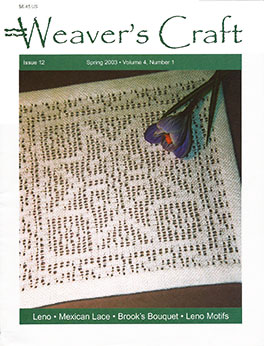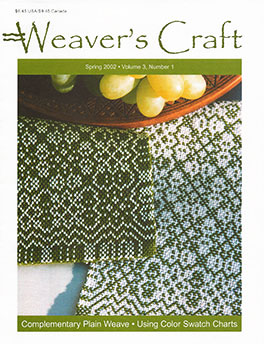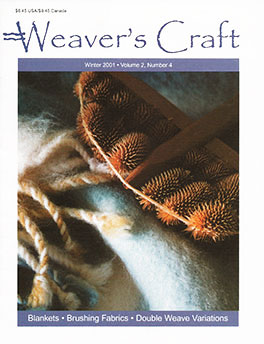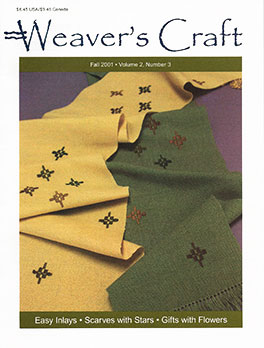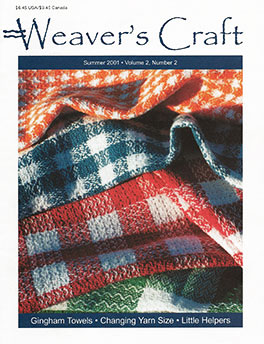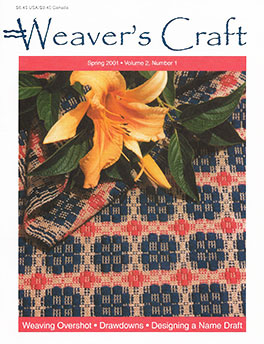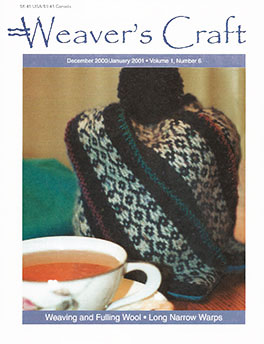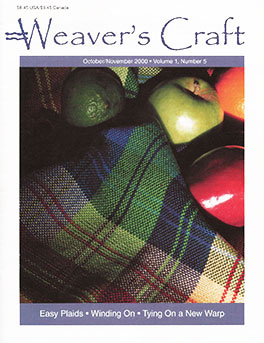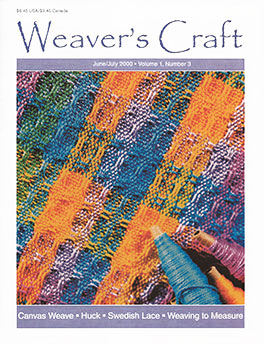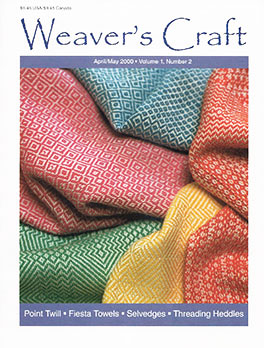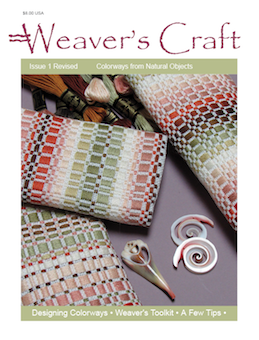Back Issues of Weaver’s Craft
Please note: I no longer ship outside the United States. See note on Home page.
Issue 31
Warp Rep
Warp rep spaces the warp ends closely to cover the weft, hiding it except at the selvedge turns. Like one of its cousins, log cabin, it's design possibilities rely on colors alternating in the warp. Heavy and fine wefts rows alternate to accent the colors on one of the two plain-weave sheds. Warp rep is threaded on pairs of shafts, each pair weaves plain weave.
Projects include Stop and Go Rep Runners, Herringbone Rep Totes, and Irish Beauty Rep Runner, which is on 8 shafts, and Warp Rep Mug Rugs.
Also included:
- How to Cut Continuous Weft Strips from T-Shirts for the Heavy Weft
Issue 30
Rosepath on Opposites
Rosepath can be treadled as a bound weave with two wefts, a pattern weft and a background weft, treadled on opposite shaft combinations to cover all the warp ends. Bound weaves cover the warp like tapestry does, but unlike tapestry, the weft travels from selvedge to selvedge.
Projects include Hugs and Kisses Mug Rugs, Higs and Kisses Runner and Mat, Portfolio in Rosepath on Opposites, and IPad Case and Camera Case.
Also included:
- Mirror-Image Floating Selvedges
- Needle-woven Rolled Edges
Issue 29
Waffle Weave
Waffle weave is a particular tie-up used with point twill threading and treadling on four or more shafts. Treadling waffle weave makes rectangular cells with long vertical and horizontal floats outlining recessed valleys. On the reverse side, the hills become valleys and the valleys hills, making the fabric reversible.
Projects include Waffle Weave Towels with Needle-Woven Edges, Embroidered Waffle Weave Towels, Waffle Weave Plaid Place Mats, Waffle Weave Thrrow, and Pistachio Waffle Scarf.
Also included:
- Double-Sided Cross Stitch Embroidery
- Waffle Weave Disasters
Issue 28
Swivel, Petit Point, & Related Laces
Swivel is a treadling method to make fabric with plain weave on the face and long floats on the back. Upon close examination, the face of a swivel fabric shows weft dots that change colors in a pattern. Petit Point is a treadling variation with all the pattern dots on the same shed.
Projects include Swivel Sampler Pillow, Wine Bottle Holder, Petit Point Tea Cozy, Lattice and Swivel Purse and Eyeglasses Case, and Two-Color Petit Point Pillow.
Also included is an article on:
- Hoosier Lace and Lattice Weave, two textures that use the same tie-up as swivel
Issue 27
Baby Blankets
A handwoven baby blanket is one of the nicest gifts a handweaver can give to welcome a baby into the world. And they are fun to weave! Learn all the background information you need about yarn choices, weave structures, sizes, and care considerations. This issue includes five blanket designs in a variety of fibers, weave structures, and colors. Projects include Atwater's Ms & Os Baby Blanket, Atwater's Basket Weave Baby Blanket, Cotton Plaid Baby Blanket, Turned Huck Blocks Baby Blanket, and Huck Squares Baby Blanket.
Also included:
- Article on Weft Angle and Draw-in
- Article on the setts to use with various sizes of knitting yarn
Issue 26
How to Turn a Draft
Turning a draft sounds easy and straightforward, but between understanding and success you may find a few surprises. In the turned version the old treadling becomes the new threading and the old threading becomes the new treadling. The weft pattern floats change to warp pattern floats. Learn about the pros and cons of turned drafts, when to use a supplementary warp, and how to deal with threads sharing dents. Projects include four-shaft projects Holiday Runner, Checkered Towels, and Pansy Towels in turned monk's belt as well as six-shaft Cameo Turned Overshot Runner.
Also included:
- Information on reading drafts and understanding brackets
Issue 25
How to Weave a Rug
When asked what is woven on a handloom, many people would say rugs. Rug weaving requires a heavy loom, perhaps heavier than the loom you have. However, you can strengthen a regular floor loom to weave a rug or you can weave rug-like projects on smaller looms. Learn how to choose warp and weft for rug weaving. Projects include the fluffy Rainbow Bright Rug woven in Peter Collingwood's double corduroy technique with strips of fleece, Simple Rag Rugs from recycled cotton fabrics, and Swedish Block Weave Placemats woven with cloth strips. Instructions include tips for using a rotary cutter to make strips.
Also included:
- Article on shuttles for rug weaving
- Article on rug tools
Issue 24
Mock Satin Damask
Do you remember the tablecloth on your mother's or grandmother's holiday dining table? It was probably white with fleur-de-lis patterning or curvilinear floral motifs that showed only in the right light. That's damask. Today's damask, however, is often woven with contrasting warp and weft colors to show the design better. Damask textiles have both warp- and weft-faced areas, pattern against background. The simplest damask structure is 1/3 and 3/1 broken twill, also called mock satin. On the same threading, the structure may also be woven as warp- and weft-faced twill. On a four-shaft loom, mock satin damask designs are easily woven with a pick-up technique, shown in two versions, one slightly faster than the other. Projects include small squares with a variety of snowflake designs and a tree design.
Also included:
- Damask Scarf on 8 shafts that needs no pick-up
- Article on How to Be a Helper
Issue 23
Barleycorn
Whether you call it Barleycorn (Gerstenkorn in German), spot weave (droppdräll in Swedish), Spot Bronson, or diaper (J. and R. Bronson's original designation), this float weave is simple to thread and weave, and it has many variations. The reversibility of the fabric and the ease of design, threading, and treadling make this weave structure very versatile. Traditionally, barleycorn was used for linen textiles, but it is wonderful for scarves, throws, and blankets as well. Projects include Yellow Barleycorn Mats or Towels with a diamond pattern, Green Barleycorn Mats or Towels with ovals, Blue Barleycorn Mats or Towels with circles and lacy blocks, and Wool Barleycorn Throw with the same pattern as the blue mats or towels, and an unusual Two-Color Barleycorn Scarf.
Also included:
- Special Selvedges for Barleycorn
- Article on Substituting Yarns
Issue 22
Twill M's and W's
The hills and valleys of point twill provide many opportunities for creative adventures. The threading drafts often have sections that look like M's or W's. Easy to design, thread, and treadle, M's and W's twillls are fast to weave with one color in the warp and a contrasting color in the weft. Use the many treadlings shown or learn to design your own variations. Put on a long warp and weave each piece with a different weft color. Named after mountains in Oregon, projects woven with 8/2 unmercerized cotton include Black Butte Twill Towels, Broken Top Twill Towels, and Three Sisters Twill Towels. M's and W's twills are also perfect for scarves, such as the Bamboo Scarf project.
Also included:
- Optimizing Floating Selvedges for Twills
- Centering Point Twill Repeats
- Designing Easy Twill Treadlings
Issue 21
Double Weave Pick-Up
Double weave is magic—at least it seems so the first time you experience it. The four-shaft loom you've been using to weave single-layer fabrics suddenly produces two layers of cloth, each of them in plain weave. Double weave pick-up exchanges the two layers in areas you control with a pick-up stick as you weave. Learn two easy step-by-step methods for working graphed designs in double weave pick-up. Projects include several Double Weave Mug Rugs and a Double Weave Checked Place Mat.
Also included:
- How to create your own graphed designs
- Warping double weave from the front of the loom
- End finishes for double weave
Issue 20
Danish Medallion and Accents for Plain Weave
With all the square intersections in woven fabric, handweavers treasure techniques that soften angularity with curves. An easy hand-manipulated technique, Danish medallion introduces graceful ovals with an embroidery-like clasp of groups of already woven rows. Learn the process of weaving Danish medallion with ovals as well as variations. Then try designing a few accent rows or scattered accents for plain-weave projects, such as guest towels. Projects include Spring Flowers Towels, Place Mats with Danish Medallion Ovals, Place Mats with Danish Medallion Stars, and Guest Towels.
Also included:
- Tips for inventing accent patterns using the twill treadles
- Hiding yarn tails when stopping and starting weft yarns
Issue 19
Log Cabin and Where It Leads
Log cabin is a color-and-weave effect in plain weave with rectangular areas of horizontal or vertical lines. Ripsmatta or warp rep is a variation that crowds the warp ends closely together. The color interaction is enhanced by weaving one row with a very heavy weft and the next with a very fine weft. Shadow weave alternates dark and light yarns in a weave structure more elaborate than plain weave. Projects include Spring Showers Baby Blanket in plain-weave log cabin with space-dyed and solid-color yarns alternating, Bamboo Shoots Rep Placemats with a heavy string yarn weft, Chenille Scarf and White Scarf in an easy-to-treadle shadow weave, and Crocus in Snow Towels and Grape Harvest Runner in shadow weave.
Also included:
- The easy way to interlock two alternating wefts at the edges of plain weave
- Tips for Keeping Your Place in Shadow Weave Treadlings
Issue 18
Principles of Classic Overshot
Overshot is a wonderfully logical system of threading and treadling that's perfect for the four-shaft loom. Although historic textiles show many divergences from classic overshot, learning the principles enables you to weave and design beautifully symmetrical patterns. Design keys, graphic representations showing the order and length of pattern blocks, make it easy to compare overshot drafts from any source to highlight their commonalities and differences. Projects include Holiday Star Towels, quick-to-weave chunky towels with Star of Bethlehem overshot, Primrose Plaid Place Mats, and Nine-Patch Place Mats.
Also included:
- Floating Selvedges for Truly Balanced Patterns
- Comparing Overshot Threadings
Issue 17
Twill and Basket Weave Combined
In the world of four-shaft weave structures, 2/2 twill and 2/2 basket weave are an admirable match because their float lengths are the same. They contrast beautifully whether in the warp or weft. The linear grid of basket weave sets off the diagonal movement of twill and its variations. Projects include Classic Twill Towels (shown in the cover photo), Twill Stripes Towel, Twill Mosaic Towels, and Twill Squares Towels.
Also included:
- What Size Shall I Make My Towel?
- Finishing the Ends of Towels
Issue 16 Vol 5, No 1 Spring 2004
Monk's Belt and Bias Cloth Strips
Cloth cut on the bias (45-degree diagonal) is stretchy and easy to mold. As pattern weft, it constricts to intersect the ground fabric and then flares out to provide coverage for floats. Bias doesn't ravel but forms short fringes on each side of the strip. As pattern weft in monk's belt fabrics, bias cloth strips can look like chenille after the fabric is washed. Several projects woven in monk's belt show the effects of sizing up both pattern and background yarns to make heavier fabrics. Projects include Cloth Strip Totes, Chenille Gridwork Pillows, Purse on a String, place mats, and a bias Striped Tea Cozy and Napkins.
Also included:
- How to cut bias from any width fabric
- Using a triangle to weave balanced fabric
Issue 15 Vol 4, No 4 Winter 2003
Kitchen Dye Techniques
I confess: traditional methods of dyeing based on industrial methods cause my head to go to sleep. I am more at ease with simplified kitchen methods and common sense with a simple method that I can repeat easily from my notes. A good dye to start with is MX-fiber reactive dye for cotton (and other cellulose-type fibers). This method involves soaking small skeins of yarn in a dye activator, dyeing with small amounts of dye in clear plastic drinking cups, and placing the skeins in plastic sandwich bags to set the dye. Also shown is a simple way to get eight shades of the same color, from dark to light.
Also included:
- Painting yarns
- Winding yarn on a niddy noddy
- Dyeing with Kool-Aid
Issue 14 Vol 4, No 3 Fall 2003
Summer & Winter
Usually a multishaft weave structure, weaving summer & winter on four shafts provides five texture variations on two threaded blocks. But with an easy and fast pick-up technique, impressively large designs can be woven. Two techniques, the traditional method and the simple method, allow you to weave runners or place mats with Snowflake, Star, Deer, Quilt Block, Heart in Hand, and Medallion motifs. Other projects include Hopi Maze Place Mats to amuse and entertain waiting children and Peace Towels with borders reading either Peace or Whirled Peas (your choice).
Also included:
- How to fix a crazy shuttle pass
Issue 13 Vol 4, No 2 Summer 2003
Four-Shaft Twill Sampler
Compare a woven cloth to the black and white squares of a graphed drawdown and you'll quickly realize the shortcomings of the graphed representation. As absolutely indispensable as drawdowns are, their rigid rows of squares are mocked by the yarns of the cloth, which nestle together according to their own rules. Explore the possibilities of four-shaft straight twill threadings by choosing from sixty-two treadling variations (you can design even more yourself), and weave a reference sampler or several Sampler Hand Towels, Guest Towels, and Cord Weave Scarf.
Also included:
- Using a basic tie-up for any shaft combination
- How to prevent (or catch) mistakes
Issue 12 Vol 4, No 1 Spring 2003
Leno, Mexican Lace, Brook's Bouquet, and Leno Motifs
Enlarging some of the openings between a fabric's threads forms lace, and these laces are formed by manipulating the warp ends through twisting or wrapping. A pointed pick-up stick and small boat shuttle make twisting easier than you imagine.
Projects include a leno sampler striped valance for a kitchen window, lace sampler place mats (each one different), and designing your own lace motifs.
Also included:
- Hems plus lace—an ideal combination
Volume 3
Issue 11 Vol 3, No 1 Spring 2002
Complementary Plain Weave
Have you wanted a technique to weave place mats heavy enough to lie flat and smooth on the table but with thin threads for a variety of delicate patterns? This four-shaft weave structure has two colors in the warp and one weft. The warp colors alternate between top and bottom of the fabric, which looks like plain weave on both back and front. Patterns are easily adapted from overshot threadings.
Projects include snack mats, place mats, bookmarks, sachets, and pin cushions.
(There is only one issue in Volume 3; I skipped three issues to get caught up.)
Volume 2
Issue 10 Vol 2, No 4 Winter 2001
Designing a Double-Width Blanket
We often think of our loom's weaving width as a limiting factor for the widest cloth we can weave. While textiles woven in panels and seamed together offer much room for creativity, double weave allows you to weave a fabric up to twice as wide as your loom, as long as you're willing to give up half the shafts to the other layer.
Projects include a double-width plain-weave blanket on four shafts, a double-width twill blanket on eight shafts, a double-width baby towel with bias binding cut from a handwoven tubular striped fabric.
Also included:
- Brushing fabrics by hand
- Making twisted fringe
- Invaluable tips to weave a smooth fold
Issue 9 Vol 2, No 3 Fall 2001
Easy Inlays
Inlay is like embroidering on the loom. It's a motif set into a background fabric while you're weaving. But weaving an inlay motif is often faster than embroidering. See how to position and weave inlays with the tails and turns on the back of the fabric. Using a space-dyed yarn gives color movement to each motif.
Projects include a scarf with inlaid star motifs, pillows with inlaid Vs and Xs, and an armoire set with tiny flowers and leaves.
Also included:
- Inlay with space-dyed yarn
- Weaving for cutting apart
Issue 8 Vol 2, No 2 Summer 2001
Gingham Kitchen Towels in Four Sizes of Checks
Wouldn't it be great to have a design for towels so foolproof that you could weave them almost in your sleep? How about one using a familiar threading and standard tie-up that allows you to run up and down the treadles yet make different little patterns? Here are wonderful little textures as well as tips for easy and fast color changes. Although the towels shown are white plus a color, make yours in any color combinations you like.
Also included:
- Using different setts and yarn sizes
- An easy way to dent 2, 1
- Little helpers that make a difference
Issue 7 Vol 2, No 1 Spring 2001
Weaving Overshot
Overshot is a weave structure admirably suited to the four-shaft loom because of the almost limitless number of possible pattern variations. We discuss how to keep your place in long threading and treadling repeats, how to weave without a written treadling, making a weft drawdown to see the pattern on paper, coordinating floating selvedges with plain weave.
Projects include Sweet-Briar Beauty Runner and Place Mats, Drawstring Bags in Overshot Name Draft, and Bagatelle Place Mats.
Also included:
- Make a drawdown to troubleshoot errors
- Who brought overshot coverlets to North America?
- Designing name drafts
- How to weave fast
Volume 1
Issue 6 Vol 1, No 6 December 2000 / January 2001
Weaving and Fulling Wool
Like our hair, wool fibers are covered with scales that overlap in one direction. When the fibers move, overlapping scales let the fibers travel forward but not back. Fibers moving through a fabric entangle, binding the collection of fibers more tightly the more they move. Fulling is a finishing process for wool fabric that uses moisture and agitation to shrink and thicken the cloth. We discuss weaving with soft, stretchy yarns because fabrics for fulling need to be woven loosely so that they are still soft after shrinking.
Projects include Origami Pillows, Swirl Hat or Tea Cozy, the Breakers Scarf.
Also included:
- Working with long, narrow warps
- Calculating take-up and shrinkage by percentage
Issue 5 Vol 1, No 5 October / November 2000
Warping from the Front of the Loom, Part Three: Winding On the Warp
A well-wound warp has two requirements. First, all threads must stay equal in length throughout the layers wound onto the warp beam. Second, the warp must be wound on as least as tight as the tension you set each time you bring the warp forward to weave. We discuss warping materials, lacing on to the front stick, checking for threading errors, and weaving the heading.
The projects are plain-weave towels designed in tartan-like plaids.
Also included:
- Tying on a new warp
- Tying a weaver's knot
- Finding order in the cross
Issue 4 Vol 1, No 4 August / September 2000
Warping from the Front of the Loom
Warping the loom from front to back is direct and fast and doesn't require any extra equipment, such as lease sticks or raddle. The warp is first sleyed in the reed, then the heddles are threaded, the warp ends are tied to the back stick, and the warp is wound on through the reed and heddles. Follow several tips for avoiding common pitfalls. In Part One—Making the Warp, see how to wind and tie off a warp for front-to-back threading. In Part Two—Threading the Loom, see how to handle one or several yarn bouts without tangling.
The project is Potpourri Warp Pillows from a warp that's designed in the reed to intermingle an assortment of different yarns.
Also included:
- Some useful knots
- Interlocking the wefts at selvedges
- Secondhand yarn, trash or treasure?
Issue 3 Vol 1, No 3 June / July 2000
From Canvas Weave to Huck and Swedish Lace
Remember the three-thread floats at the center of twill diamonds in Issue 2? Now we'll develop those floats into a family of spot weaves and woven laces. A spot is merely a three-thread float in plain weave. Woven laces repeat these floats to cluster yarns into a group that separates itself from neighboring groups.
Projects include textured face cloths, towels, and placemats.
Also included:
- Making a notebook for yarn setts and sizes
- Weaving to measure with paper tape
- Weaving and sewing hems
Issue 2 Vol 1, No 2 April / May 2000
Point Twills
The large twill family with its signature diagonal lines contains a surprising variety of patterns and textures. We look at simple four-shaft point twills treadled two shafts up and two shafts down. With four treadles tied up and a shuttle of colorful weft, you're ready to explore a fascinating group of easy twills in five colorful fiesta towels.
Also included:
- How to thread heddles
- Smiling selvedges and loose edge threads
- Skipped selvedge threads and floating selvedges
Issue 1 Revised October 2018
Colorways from Natural Objects
Look closely at a natural object and you'll see a surprisingly wide range of colors. Basing a color palette on an object from the natural world offers a range of nuances and shadings that work beautifully together. Once you've matched as many colors as possible to skeins of embroidery floss, learn to organize them in several ways and weave cases for glasses or IPhones in monk's belt.
Also included:
- Then and Now
- A Weaver's Toolkit
- Table Loom Tips
